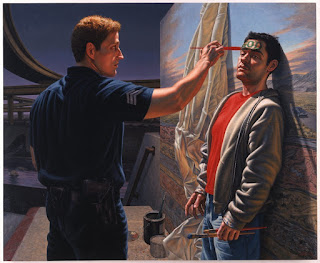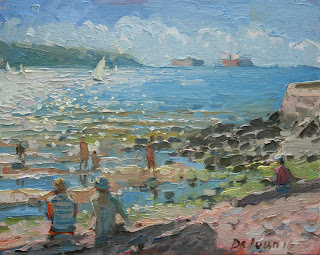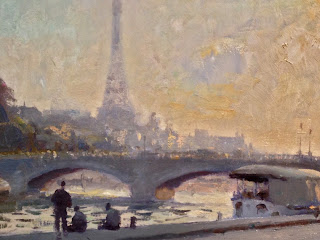Picture this: You see a portrait of a war veteran and it is clumsily drawn, the colors feel flat and cold. The flag hangs like a kitchen rag and the pose is as uninspired as a yearbook's. It doesn't even resemble the subject.
Now imagine a portrait of Donald Trump where the artists has managed to miraculously dissipate all of the arrogance and idiocy into a masterpiece of lush tones, an elegant poise and even a hint of a brain behind the constipated squint. -(Just in case you were wondering, nah, it hasn't been done.)
 |
| This is not 'tremendous' at all . But how to make a good painting out of such poor subject matter. |
Of course the answer is simple, the quality of the art is quite independent of the message it conveys.
 |
| "Three Prostitutes" Otto Dix 1925 Love this! |
I often wonder how art can help heal the world; what does it mean to make "important art? We constantly read about 'significant' works and paintings that challenge the status-quo. Are they? Did they? As much as I look I come out empty. It would appear that art has never 'created' the necessary change but only reflected it back and commented on it, sometimes acutely.
I've avoided this subject for very good reasons. People are fanatic enough already about oil mediums. Political and social issues are a whole other ball game because they involve the artist as a person and a citizen, not just as creator of works. And just in case it might sound as if I am censoring or trying to say something 'important', rest assured I am not. Most artists I know aspire to something great and it is the process of perfecting one's expression that keeps artists trying and failing, not the results per se and -definitely- not how amazing some of those artists believe these results to be.
 |
| Jan Kasparec. |
 |
| This communicates Buddhism and environmental awareness. |
Are there any bigger 'messages' today than the growing inequality of the world's wealth and the reality of environmental degradation? Everything else either pales in comparison or is a direct consequence of these global maladies. If History is any guide the planet will find balance again by its own means of disease and mass extermination. So how do you make art with that? Is it really the artist's job to even try to tackle things like these?
There's no right answer, of course. Some would say the artist must tackle what she is concerned about as a citizen only. "Just shut up and sing" as they say. Or even turn his lofty head AWAY form it and choose to ignore or even deny the issues. At least until the apocalypse withers his garden and burns the studio.
*My point is that art is probably not the right medium to affect change but a perfect means to express it.
*My second more important point is that artistic merit is indifferent to how urgent or radical the message is and a worthy message cannot insure a work of art from being awful. (Fortunately, evil messages have suffered the same lack of insurance or more.)
*The 'importance' of art often starts and ends with its importance to the artist. It only grows from there to wards the viewer, the community, the market and the world at large.
 |
| Painting exalting racial purity (Nazi period) |
I know a few artists that paint homeless people. They mostly do in an effort to convey the dignity inherent in people that normally would not be portrayed at all, anywhere, and much less be able to pay for the luxury. Not your run-of-the mill "pretty" subject matter. And easy to sentimentalize to boot. I like all of the following works. I especially like the one of the multiple boards stuck together because it makes the homeless the authors and they were paid for their words. The Bastien Lepage is just phenomenally well painted and it has charm for miles. Fit for a chocolate box though. It also has a message but I'd say it is more of a literary type, heartfelt as it is. The Jose Ribera is just powerful, unflinching and probably the superior piece.
 |
| Bastien LePage. "Pas Meche" 1882 |
 | ||
| A board made with homeless signs purchased from the writers. Artist: Willie Baronet. |
 |
| well-wishing graffiti by Skid Robot. |
 |
| Jose Ribera "Clubfooted boy or the beggar" 1642 |
Let's move on to the subject of war. Without a doubt , one of the most represented subjects in History. From heroic generals to fields of strewn corpses, war paintings are everywhere. Let's look at recent examples. Sargent, whom nobody would accuse of being a hack, created his incredible "Gassed" painting after briefly visiting the front at the age of 62. It is a masterpiece of light and composition but "war" it ain't. Oh, yes, there are soldiers and wounds and dead people but Sargent might as well have painted a row of angels. It resembles more of an heroic Hellenistic frieze than a war condemnation. He might have been affected by what he saw but really didn't set out to question the war or war mongers .
 |
| "Gassed" S.Sargent. 1919 |
Next is someone that goes a step beyond Sargent, may be not in technique, but in message. We have a wailing mother holding a mutilated soldier over some oil burning fields. Oil for blood. Not a frieze, but a 'Pieta'. Clearly, the artist has some very strong opinions about this and has focused the scene eliminating other corpses and avoiding contemporary clothing on the mother figure. She is both symbolic and realistic. The American flag does not have a single stain despite being crumpled under the agonizing soldier (the painter is buying insurance here since patriotism is beyond reproach -and the last refuge of scoundrels as they say) . The work is well painted but -and you may disagree- it is a scene in a play. So poised and theatrical that I don't think it is too far off , indictment-wise, from the Sargent in leaving us cold. I love it as an illustration. No more.
 |
| Max Ginsburg. "War Pieta" 2017 |
Now, here it is. Even better and edited down. The horror of war. No mom coming to cry. No patriotic hints. No face to recognize. No heroic pose. Just mud and shit and this was someone who went to help (he is a red cross soldier) and got gassed instead. I really nails the point and this painting hasn't left my head since I saw it two years ago. We are in Goya territory here as far as driving the message home.
 |
| Ardius Fidelis. Gilbert Rogers 1919 |
And, oh the irony, that most capitalist of artists, Mr. Bansky, going directly to the thinking cap. Two childish characters ( pst, they are really stand-ins for large corporations) holding the hands of a Vietnamese real life child burnt by a war chemical. How much do these children-loving logos really give a flying crap? And Bansky didn't even have to create anything but combine a few iconic images -my opinion. Is this a war painting/image? I'd say 'yes' and its offensive value is off the charts because any war, just or unjust, should leave one offended, not exalted. The funny thing is that it is a stretch to call this a painting, but few would argue that it is not art.
May be paintings are not the right way to express disent or rock the boat. More on this later.
 |
| Banksy |
And what about feminism? Did pop-art endless display of vaginas, vacuum cleaners and Barbie dolls stir the masses towards an improvement in women's status? In my opinion they might have helped reclaim art as a feminine endeavor. Big iffy "might".
 |
| Marie Chorda. 'Great Vagina' |
-If you've lived in any population (Los Angeles, for example) where there has been a racial minority (even though 'latino' populace is now a majority in LA) or native population in need of reclaiming some pride, you've seen the murals. Some are riots of color, direct and, well, proud, but few are also good. Criticizing the quality of the mural is often tantamount to criticizing the message. You either like it or you clearly are an 'imperialist' parading Western post-colonial prejudice. I don't care. Some of these murals are lurid messes with little merit. It really has nothing to do with the sympathy their message might stir in the viewer. I am sure I can find some examples of well executed murals painted by the people claiming their space.
 |
| Cesar Chavez portrait in mural form. artist? |
For contrast, the great Mexican muralist Diego Rivera.....well, true, he was not a struggling immigrant. He was also well aware of the Western art world and therefore had a large advantage. OK! May be not the best example of "urgency". But he could convey the anti-imperial anti-capitalist message liek nobod's business. As I said, I will look for examples of "good" murals made by the people they are intended to portray. There's got to be a few as the gift of art does not stop at the strawberry fields of Camarillo or the Laguna Beach mansions.
 |
| Diego Rivera. "The river" mural |
Economic inequality is a tough one. Art is considered a luxury item so who in their right mind would paint something that goes against the very belief in luxury? But that hasn't stopped artists who wanted to make a name for themselves and make a splash. After all, even corporations are not always opposed to own their own critics as long as they can hang them in a lobby and not in their conscience. The mansions of moguls are filled with images of peasants and their quaint simple lives. The offices of real estate titans often feature beautiful animal sculptures and landscapes of the West.
Anyway, nothing new here. At this point I think we get the idea. There are many other areas of meaning like art done as therapy which I'd love to talk about or environmental art, native art, propaganda ... The citizen artist is allowed to be stirred by his day to day concerns and worries, could he or she do otherwise?
 |
| "And They Still Say Fish Is Expensive!" Joaquin Sorolla. 1894 |
 | ||
| Alex Schefer. "Burning Bank of America" |
 |
| James Gillray. 1805. "The plumb-pudding in danger" |
I am sure the painting below has some meaning -something about the story of a young artist's rise to maturity I read. It is part of a series much like Hogarth's "A Rake's Progress" or a "Book of Hours". It has nicely rendered lights and fabrics and it's finished within an inch of its life with Germanic thoroughness. The scene is a puzzle but between reading about it to find out and just moving on I'd rather do the latter because I doubt I'd be impressed. May be this piece is a victim of its own "cleverness" and a perfect example of that large group of artworks that belong in the ivory tower of academia art, if not academic; enigma art, if not enigmatic. But it wants to be an 'important' piece, it wants it so bad. I am sure it is important for the artist, and may be that should be enough.
 |
| artist: Scott Hess |
































